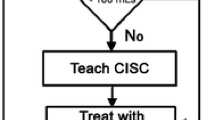Abstract
Detrusor sphincter dyssynergia (DSD) is an involuntary contraction of the external urethral sphincter during detrusor contraction. A high proportion of patients needing repeat surgery and long term failure have both been described in the literature. In the present study, we evaluated clinical characteristics, underlying disorders and outcomes of conservative medical treatment in 21 female patients. Two patients were newly diagnosed multiple sclerosis. Urodynamic studies were performed in all symptomatic patients, and consisted of measurement of post-micturition residuals, urethral pressure profilometry and EMG cystometry according to the criteria of the International Continence Society. All patients were treated with baclofen 15 mg/day and doxazosin 4 mg/day. Seven patients received tolterodine 4 mg/day in addition to baclofen and doxazocin because they had detrusor hyperreflexia (DH). In conclusion, treatment with either combined baclofen and doxazosin or anticholinergic agent tolterodine appeared to be effective. In addition, it should be kept in mind that DSD could be the first sign to any neurologic diseases.
Similar content being viewed by others
References
Gordon D, Groutz A (2002) Evaluation of female lower urinary tract symptoms overview and update. Curr Opin Obstet Gynecol 13:521–527
Groutz A, Blaivas JG (2002) Non-neurogenic female voiding dysfunction. Curr Opin Urol 12:311–316
Andersen JT, Bradley WC (1976) The syndrome of detrusor sphincter dyssynergia. J Urol 116:493–495
Galloway N, Mekras JA, Helms M, Webster GD (1991) An objective score to predict upper urinary tract deterioration in myelodysplasia. J Urol 145(3):535–537
Gerridzen RG, Thijssen AM, Dehoux E (1992) Risk factors for upper tract deterioration in chronic spinal cord injury patients. J Urol 147:416–418
Yalla S, Fam BA (1991) Spinal cord injury. In: Krane RJ, Siroky MB (eds) Clinical neurourology. Boston 319–332
Kiesswetter H, Schober W (1975) Lioresal in the treatment of neurogenic bladder dysfunction. Urol Int 30:63–69
Dmochowsky RR, Ganabathi K, Leach GE (1995) Non-operative management of the urinary tract in spinal cord injury. Neurourol Urodyn 14:47–55
Lockhardt JL, Vorstman B, Weinstein D, Politano VA (1996) Sphincteromy failure in neurogenic bladder disease. J Urol 135:68–69
Juma S, Mostafavi M, Joseph A (1995) Sphincterotomy: long term complications and warning signs. Neurourol Urodyn 14:33–41
Yang CC, Mayo ME (1995) External urethral sphincterotomy: long-term follow up. Neurourol Urodyn 14:25–31
Dysktra DD, Sidi AA, Scott AB, Pagel JM, Goldish GD (1988) Effects of botulinium A toxin on detrusor sphincter dyssynergia in spinal cord injury patients. J Urol 139:919–922
Hambleton P (1992) Clostridium botulinum toxins: a general review of involvement in disease, structure, mode of action and preparation for clinical use. J Neurol 239:16–20
Abrams P, Blaivas JG, Stanton SL, Andersen JT (1989) The standardization of terminology of lower urinary tract function; produced by the International Continence Society Committee on Standardization of Terminology. World J Urol 6:233–245
Blaivas JG (1981) Detrusor-external dyssynergia. J Urol 125:542–544
Patel R, Nitti V (2001) Bladder outlet obstruction in women prevalence, recognition, and management. Curr Urol Rep 2:379–387
Turner-Warwick R, Whiteside CG, Worth PH, Milroy EJ, Bates CP (1973) A urodynamic view of the clinical problems associated with bladder neck dysfunction and its treatment by endoscopic incision and trans-trigonal posterior prostatectomy. Br J Urol 45:44–59
Kranse R, van Mastrigt R (2002) Relative bladder outlet obstruction. J Urol 168:565–570
Cormier L, Ferchaud J, Galas JM, Guillemin F, Mangin P (2002) Diagnosis of female bladder outlet obstruction and relevance of the parameter area under the curve of detrusor pressure during voiding preliminary results. J Urol 167:2083–2087
Blaivas JG, Groutz A (2000) Bladder outlet obstruction nomogram for women with lower urinary tract symptomatology. Neurourol Urodyn 19:553–564
Kuo HC (2000) Videourodynamic study for diagnosis of bladder outlet obstruction in women. J Form Med Assoc 99:386–392
Nitti VW, Tu LM, Gitlin J (1999) Diagnosing bladder outlet obstruction in women. J Urol 161:1535–1540
Blaivas JG, Sinha HP, Zayed AA, Labib KB (1981) Detrusor-external sphincter dyssynergia. J Urol 125:542–544
Yalla SV, Blunt KJ, Fam BA, Constantinople NL, Gittes RF (1977) Detrusor-urethral sphincter dyssynergia. J Urol 118:1026–1029
Billinton A, Ige AO, Bolam JP, White JH, Marshall FH, Emson PC (2001) Advances in the molecular understanding of GABAB receptors. Trends Neurosci 24:277–282
Vaidyanathan S, Soni BM, Oo T, Hughes PL, Singh G, Mansour P (2004) Delayed complications of discontinuation of intrathecal baclofen therapy: resurgence of dyssynergic voiding, which triggered off autonomic dysreflexia and hydronephrosis. Spinal Cord 42:598–602
Leyson JF, Martin BF, Sporer A (1980) Baclofen in the treatment of detrusor-sphincter dyssynergia in spinal cord injury patients. J Urol 124:82–84
Haubensak K (1977) A double-blind trial with the antispasticity drug Lioresal in 15 paraplegics with upper neuron lesions. Urol Int 32:198–201
Kiesswetter H, Flam J, Hennrich F, Summer K, Schober W (1980) Urological complications in patients with multiple sclerosis. Wien Klin Wochenschr 92:16–22
Author information
Authors and Affiliations
Corresponding author
Rights and permissions
About this article
Cite this article
Kilicarslan, H., Ayan, S., Vuruskan, H. et al. Treatment of detrusor sphincter dyssynergia with baclofen and doxazosin. Int Urol Nephrol 38, 537–541 (2006). https://doi.org/10.1007/s11255-006-0071-9
Received:
Accepted:
Published:
Issue Date:
DOI: https://doi.org/10.1007/s11255-006-0071-9




